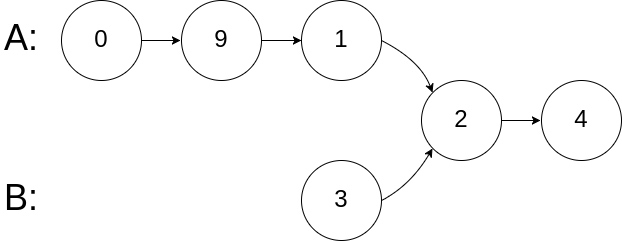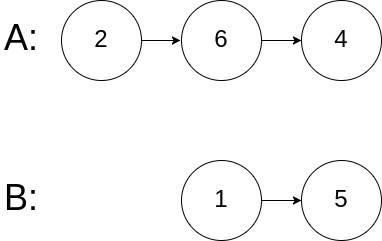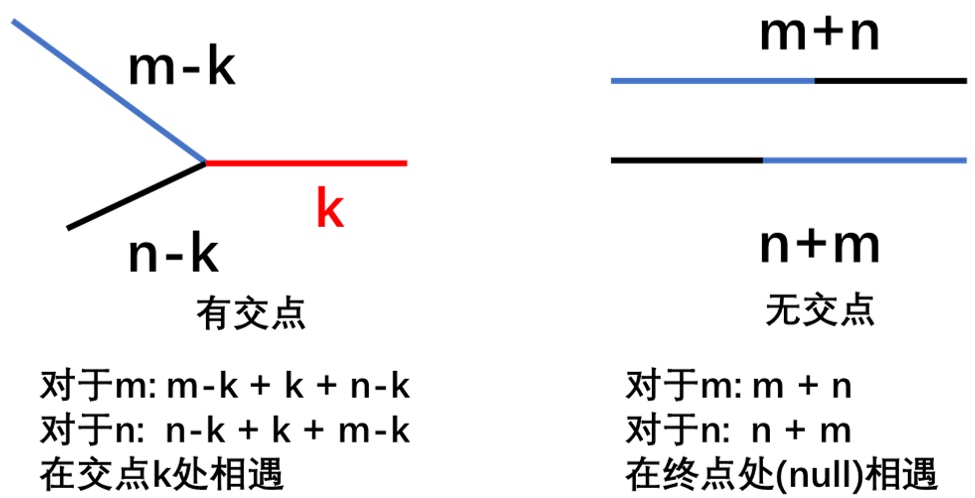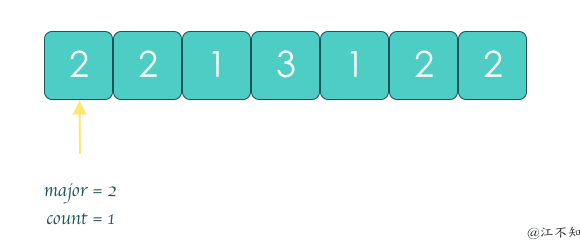LeetCode day7
160. Intersection of Two Linked Lists
Topic: Linked list
Write a program to find the node at which the intersection of two singly linked lists begins.
For example, the following two linked lists:
 begin to intersect at node c1.
begin to intersect at node c1.
Example 1:

Input: intersectVal = 8, listA = [4,1,8,4,5], listB = [5,0,1,8,4,5], skipA = 2, skipB = 3
Output: Reference of the node with value = 8
Input Explanation: The intersected node's value is 8 (note that this must not be 0 if the two lists intersect). From the head of A, it reads as [4,1,8,4,5]. From the head of B, it reads as [5,0,1,8,4,5]. There are 2 nodes before the intersected node in A; There are 3 nodes before the intersected node in B.Example 2:

Input: intersectVal = 2, listA = [0,9,1,2,4], listB = [3,2,4], skipA = 3, skipB = 1
Output: Reference of the node with value = 2
Input Explanation: The intersected node's value is 2 (note that this must not be 0 if the two lists intersect). From the head of A, it reads as [0,9,1,2,4]. From the head of B, it reads as [3,2,4]. There are 3 nodes before the intersected node in A; There are 1 node before the intersected node in B.Example 3:

Input: intersectVal = 0, listA = [2,6,4], listB = [1,5], skipA = 3, skipB = 2
Output: null
Input Explanation: From the head of A, it reads as [2,6,4]. From the head of B, it reads as [1,5]. Since the two lists do not intersect, intersectVal must be 0, while skipA and skipB can be arbitrary values.
Explanation: The two lists do not intersect, so return null.Notes:
- If the two linked lists have no intersection at all, return null.
- The linked lists must retain their original structure after the function returns.
- You may assume there are no cycles anywhere in the entire linked structure.
- Your code should preferably run in O(n) time and use only O(1) memory.
Approach1
通常做这种题的思路是分别为链表A和链表B设置指针A和指针B,然后开始遍历链表,如果遍历完当前链表,则将指针指向另外一个链表的头部继续遍历,直至两个指针相遇.
值得注意的是,无论是相交还是不相交,对于无环的链表来说,都一定会相遇,因此不会死循环

def getIntersectionNode(headA, headB):
ha, hb = headA, headB
while ha != hb:
ha = ha.next if ha else headB
hb = hb.next if hb else headA
return ha169. Majority Element
Topic: Bit manipulation, Array, Divide and Conquer
Given an array of size n, find the majority element. The majority element is the element that appears more than ⌊ n/2 ⌋ times.
You may assume that the array is non-empty and the majority element always exist in the array.
Example 1:
Input: [3,2,3]
Output: 3Example 2:
Input: [2,2,1,1,1,2,2]
Output: 2Approach1
投票算法: 通过不断消除不同元素直到没有不同元素, 剩下的元素就是要找的元素.

def majorityElement(nums: List[int]) -> int:
major = nums[0]
count = 1
for i in nums[1:]:
if i == major:
count+= 1
elif count == 0:
major = i
else:
count -= 1
return major时间复杂度:O(N),其中N为数组长度 空间复杂度:O(1)
Approach2
dic (这个方法严格要求major是 more than [n/2], 而上面的投票法只是求众数) E.g. [2,4,1,3,1,2,2] dic方法的输出是null, 而投票法的输出是2
def majorityElement(nums: List[int]) -> int:
n = len(nums)
dic = {}
for i in range(n):
dic[nums[i]] = dic.get(nums[i],0) + 1
if dic[nums[i]] > n/2:
return nums[i]171. Excel Sheet Column Number
Topic: Math
Given a column title as appear in an Excel sheet, return its corresponding column number.
For example:
A -> 1
B -> 2
C -> 3
...
Z -> 26
AA -> 27
AB -> 28
...Example 1:
Input: "A"
Output: 1Example 2:
Input: "AB"
Output: 28Example 3:
Input: "ZY"
Output: 701Approach1
26进制转十进制
ord() :返回对应的 ASCII 数值, ord(‘a’) –> 97, ord(‘A’) –> 65
def titleToNumber(s: str) -> int:
res = 0
bit = 1
for a in s[::-1]: # 从左到右
res += (ord(a) - 64) * bit # i.e. 'A'-> 65 - 64 = 1
bit *= 26
return resApproach2
same but neat
def titleToNumber(s: str) -> int:
return sum( (ord(a) - 64) * (26 ** i) for i, a in enumerate(s[::-1]))Approach3
same but with ord()
def titleToNumber(s: str) -> int:
tmp ={'A':1,'B':2,'C':3,'D':4,'E':5,'F':6,'G':7,'H':8,'I':9,'J':10,'K':11,'L':12,'M':13,'N':14,'O':15,'P':16,'Q':17,'R':18,'S':19,'T':20,'U':21,'V':22,'W':23,'X':24,'Y':25,'Z':26}
s=[i for i in s]
res=0
p=1
while s:
res+=tmp[s.pop()]*p
p=p*26
return res172. Factorial Trailing Zeroes
Topic: Math
Given an integer n, return the number of trailing zeroes in n!.
Example 1:
Input: 3
Output: 0
Explanation: 3! = 6, no trailing zero.Example 2:
Input: 5
Output: 1
Explanation: 5! = 120, one trailing zero.Note: Your solution should be in logarithmic time complexity.
Approach1
要在末位产生0,则必然是5×2.
找到了n中是5倍数的所有数,例如25,即在25!中找到了5个是5的倍数的数分别为5,10,15,20,25
def trailingZeroes(n: int) -> int:
p = 0
while n >= 5:
n = n // 5
p += n
return pApproach2
my, but if n too big, then overtime.
def trailingZeroes(n: int) -> int:
res = 1
cnt = 0
for i in range(1,n+1):
res *= i
for j in str(res)[::-1]:
if j =='0':
cnt += 1
else:
break
return cnt